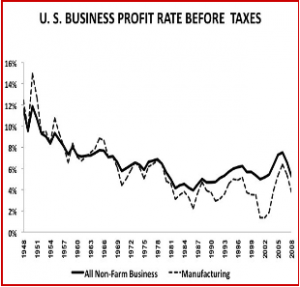From Red Flag April 21, 2010
In the last issue, we learned that a dialectical contradiction is a unity and struggle of opposites things or processes which are connected, but which interfere with each other and cause change. We found that contradictions tend to become more intense, that is, the two opposite sides interfere with each other more. When contradictions reach a peak of intensity, they are resolved, like the worker capitalist contradiction, which is resolved by communist revolution. In this issue, we discuss some basic contradictions in the capitalist economy.
The Falling Rate of Profit
One of the reasons identified by Marx that the contradictions of capitalism tend to become sharper is the tendency of the rate of profit to fall. This means that the rate of profit on each dollar invested tends to get smaller over time. Because of competition, each capitalist must try to produce things more cheaply than the next one. Individual capitalists lower production costs by introducing more machinery into production, thereby reducing the number of workers. Other capitalists are then forced to automate in order to keep up. The result is a much larger amount of money sunk into technology.

Graph of the Falling Rate of Profit in the US
More money spent on machinery means a lower rate of profit because of one key fact: Workers’ labor is the source of all value. Profits are only made from workers labor, by capitalists making workers produce much more value than the workers get in wages. The value produced by the labor that capitalists don’t pay for is called “surplus value,” and it is the ultimate source of profit, interest, and rent.
There are several ways that capitalists can try to counteract the fall in the rate of profit, like reducing the wages of workers. Capitalists can do this directly, or they can move production to areas that already have lower wages, like the southern U. S, Mexico, or Asia. The U.S. automakers, for example, have been making cars and car parts in Mexico and Brazil for a long time. This not only means that they can hire workers for less in those countries, but the threat of moving jobs away helps the auto bosses keep U. S. workers’ wages down. Inside the U. S., capitalists are also reducing wages by making greater use of racism, super-exploiting a section of the working class, for example, by increased use of immigrant labor in basic industries. This is particularly true of the companies that outsource production to lower wage, non-union shops. The result of all these changes has been a significant decline in wages and cutbacks in benefits since the 1970s.
The intensifying contradiction between workers and capitalists can be seen in the current economic crisis [as of 2010]. As capitalists try to cope with the weaknesses of their system, they are increasing their attacks on workers, laying them off, cutting back on their health care and education, foreclosing on their houses, and sending them off to wars like Iraq and Afghanistan for capitalists’ profits and resources.
While we should join in and lead the resistance to cuts and layoffs that is now taking place against these attacks, reform movements will not prevent things from getting worse for workers and students. The weaker the U. S. capitalists get, the less room they have to make concessions to angry workers. The future of capitalism holds only more misery, war and further steps toward fascism until revolution destroys capitalism and resolves the worker capitalist contradiction.
One Side of a Contradiction Is Dominant
In the conflict between the two sides of a contradiction, one side is almost always dominant. Situations where the two sides are “even” are rare and temporary. But the dominant side does not have to stay dominant. The side that is dominant needs to fight to stay on top. The other side fights to gain the upper hand.
Competition is a kind of contradiction, and capitalists in competition with each other have to do whatever it takes to keep up with their competitors. Even capitalists who are in a strong position for the moment know that they can lose. General Motors was riding high for decades, but has finally lost out to its competitors, especially to Toyota, and gone bankrupt [as of 2009].
Imperialist countries of the past, like Spain or Britain, who were dominant for a while, have ended up as minor powers. They lost out in the struggle and their imperial power was destroyed. Now the U. S. empire is facing increasing challenges from Russia, China and Europe. While it remains the dominant power, that situation will not last indefinitely.
These intensifying contradictions in the world tend to intensify the contradictions in pro-capitalist thinking, and this represents an opportunity for the growth of the communist movement. More people are questioning the system and are open to a communist analysis of it. The same is true of the Obama administration’s major escalation of the war in Afghanistan [as of 2010], as the contradictions of the economy drive the U. S. capitalists to greater efforts to control the world’s main sources of oil and gas. All aspect of U. S. capitalism are gearing up for war, including the military, industry, education, and even health care. This process will intensify the contradiction between capitalism and the international working class, moving toward resolving it with revolution.

